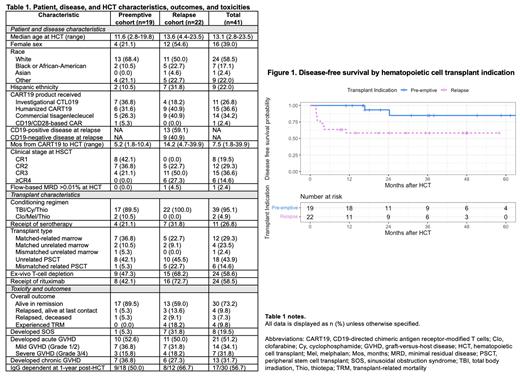Introduction: CD19-directed chimeric antigen receptor-modified T cells (CART19) induce remarkably high remission rates in relapsed/refractory B-lymphoblastic leukemia (B-ALL), but 50% of children and young adults experience subsequent relapse. Allogeneic hematopoietic cell transplant (HCT) is frequently used after CART19, either for relapse prevention or to treat post-CART19 relapse. However, there is a paucity of safety and outcome data after HCT in this population. This gap is especially relevant because patients often undergo HCT post-CART19 later in their relapsed disease courses (i.e., CR3 or later) than historical patients undergoing HCT for B-ALL.
Methods: We conducted a retrospective review of patients aged <30 years with B-ALL who underwent a first HCT for remission consolidation (preemptive cohort) or relapse therapy (relapse cohort) after CART19 at the Children's Hospital of Philadelphia between 2014-2022. The primary outcome was disease-free survival (DFS) from HCT, stratified by cohort. Secondary outcomes included overall survival (OS) and frequency of transplant-related mortality (TRM), graft-versus-host disease (GVHD), sinusoidal obstruction syndrome (SOS), and IgG replacement dependence.
Results: The analysis included 41 patients: 19 in the preemptive cohort (pre-planned consolidative HCT, n=5; early loss of B cell aplasia, n=13; positive next-generation sequencing minimal residual disease [MRD], n=1) and 22 in the relapse cohort (morphologic relapse, n=18; detectable flow-based MRD, n=4) (Table 1). With one exception of a patient treated with a CD19/CD28-based product, all patients received investigational or commercial CD19/4-1BB CAR T cells. Median time from CART19 infusion to HCT was 5 months (range, 2-10) for the preemptive and 14 months (range, 5-40) for the relapse cohort. Between CART19 and HCT, 6/19 (32%) preemptive patients received bridging therapy (chemotherapy, n=3; blinatumomab, n=1; inotuzumab, n=2). In the relapse cohort, salvage therapies that successfully induced HCT-acceptable remissions (MRD <0.1%) included inotuzumab (n=11, 50%), cytotoxic chemotherapy (n=5, 23%), blinatumomab (n=2, 9%), CART22 (n=2, 9%), CART19 reinfusion (n=1, 5%), or pembrolizumab (n=1, 5%).
At HCT, the majority (79%) of the preemptive cohort was in CR1 or CR2; whereas, the majority (77%) of the relapse cohort was in ≥CR3. All patients received myeloablative conditioning, either total body irradiation-based (n=39) or clofarabine-based (n=2), and 59% received a T cell depleted graft.
In the preemptive cohort, with a median follow-up of 36 months, DFS at 1, 2, and 3 years after HCT was 100%, 93% (95% CI, 61-99), and 85% (95% CI, 51-96), respectively (Fig. 1). OS was 100% through 3 years. In the relapse cohort, with a median follow-up of 34 months, DFS was 58% (95% CI, 35-76) and OS was 68% (95% CI, 44-83) by 1 year, and remained the same through 3 years (Fig. 1). When stratified by CD19 immunophenotype at post-CART19 relapse, DFS by 1 year was 67% (95% CI, 34-86) for CD19-positive and 44% (95% CI, 14-72) for CD19-negative disease (p=0.235).
Frequently observed toxicities included GVHD and SOS. In the preemptive cohort, 10 patients (53%) developed acute GVHD (3 [16%] were grade ≥3) and 7 (37%) developed chronic GVHD. In the relapse cohort, 11 patients (50%) developed acute GVHD (4 [18%] were grade ≥3) and 6 (27%) developed chronic GVHD. SOS was observed in 1 (5%) preemptive patient and 7 (32%) relapse patients. Four patients (18%), all in the relapse cohort, died of TRM between days +47-65 after HCT. Three had multisystem organ failure in the setting of multiple complications, including severe SOS. One had respiratory failure due to presumed adenoviral pneumonitis. At 1 year post-HCT, 9/18 (50%) preemptive and 8/12 (67%) relapse patients who remained event-free still required IgG replacement.
Conclusion: In children receiving their first HCT for post-CART19 remission consolidation, DFS and OS were exceptionally good, without any observed TRM and with comparable rates of GVHD and other major complications to general pediatric HCT populations. For children who were able to undergo HCT following a post-CART19 relapse, of which 77% were in CR3 or later, DFS and OS were also favorable. The majority became long term survivors and all events occurred within 1 year after HCT. However, higher rates of SOS (likely associated with pre-HCT inotuzumab) and TRM were also observed in this cohort.
Disclosures
Maude:Novartis Pharmaceuticals: Consultancy, Patents & Royalties: PCT/US2017/044425: Combination Therapies of Car and PD-1 Inhibitors, Research Funding; Wugen: Research Funding. Freedman:Massive Bio, Inc: Consultancy. Grupp:Jazz: Consultancy, Membership on an entity's Board of Directors or advisory committees, Research Funding; Servier: Research Funding; Cellectis: Consultancy, Membership on an entity's Board of Directors or advisory committees; Novartis: Consultancy, Research Funding; Vertex: Consultancy, Research Funding; Kite: Research Funding; CBMG: Consultancy, Membership on an entity's Board of Directors or advisory committees; Adaptimmune: Consultancy, Membership on an entity's Board of Directors or advisory committees; Juno: Consultancy, Membership on an entity's Board of Directors or advisory committees; Allogene: Consultancy, Membership on an entity's Board of Directors or advisory committees; Cabaletta: Consultancy, Membership on an entity's Board of Directors or advisory committees. Elgarten:Allovir: Other: one time advisory committee.


This feature is available to Subscribers Only
Sign In or Create an Account Close Modal